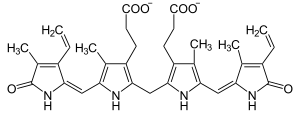Bilirubin facts for kids
Bilirubin is a yellowish stuff your body makes. It appears when your body breaks down old red blood cells. Think of red blood cells as tiny delivery trucks. They carry oxygen all around your body. After about 120 days, these trucks get old. They need to be recycled. That's where bilirubin comes in!
Imagine recycling paper. You break it down into smaller pieces to make new paper. In the same way, your body recycles old red blood cells. It breaks them down, and one of the things left over is bilirubin.
Contents
Where Does Bilirubin Come From?
Bilirubin is made in a few steps. Different parts of your body help out.
The Spleen: The Recycling Center
The spleen is an organ in your tummy. It acts like a recycling center for old red blood cells. When a red blood cell gets old, the spleen grabs it. Then it starts breaking it down.
The Liver: The Cleaning Factory
The liver is another organ in your tummy. It's like a super-important cleaning factory. After the spleen breaks down the red blood cell, the bilirubin goes to the liver. The liver changes the bilirubin. This makes it ready to be removed from your body.
The Gallbladder: The Storage Pouch
The gallbladder is a small pouch. It sits under the liver. It stores a liquid called bile. Bile helps you digest fats. Bilirubin is added to bile. Then it's released into your intestines.
The Intestines: The Exit Route
The intestines are long tubes. This is where your body digests food. In the intestines, some bilirubin is removed from your body in your poop. That's why poop is brown! A small amount of bilirubin also leaves your body in your pee.
Why Is Bilirubin Important?
Bilirubin is a normal part of how your body works. It shows that your body is doing a good job. It's recycling old red blood cells. However, too much bilirubin can cause problems.
What Happens with Too Much Bilirubin?
When there's too much bilirubin in your blood, it's called hyperbilirubinemia. This can cause a condition called jaundice. Jaundice makes your skin and the whites of your eyes look yellow.
Jaundice is common in newborn babies. Their livers are not fully developed yet. They can't remove bilirubin as quickly as older kids and adults. Most of the time, newborn jaundice goes away on its own. This happens in a few days or weeks.
Older kids and adults can also get jaundice. But it usually means there's a problem. This problem could be with the liver, gallbladder, or blood. Some things that can cause jaundice include:
- Liver problems: Like hepatitis (an infection of the liver) or cirrhosis (scarring of the liver).
- Gallstones: These are small, hard stones. They can block the flow of bile from the gallbladder.
- Blood issues: Like hemolytic anemia. This causes red blood cells to break down too quickly.
How Is Bilirubin Measured?
Doctors can measure the amount of bilirubin in your blood. They use a simple blood test. The test is called a bilirubin test.
The normal range for bilirubin levels can be different for different people. But generally:
- Total bilirubin: 0.3 to 1.0 mg/dL (milligrams per deciliter)
- Direct bilirubin: 0.0 to 0.3 mg/dL
- Indirect bilirubin: 0.2 to 0.8 mg/dL
If your bilirubin levels are higher than normal, your doctor might do more tests. This helps them find out why.
Cool Facts About Bilirubin
- The word "bilirubin" comes from Latin. "Bilis" means bile, and "ruber" means red.
- Bilirubin is not just in humans. It's also in animals. This includes birds, reptiles, and fish.
- Scientists are studying bilirubin. They want to see if it has other important jobs. Maybe it helps protect cells from damage.
Important Dates and Figures
- 1847: Bilirubin was first found by French chemist Louis-Antoine Gmelin.
- 1958: Light therapy (phototherapy) was first used. It helped treat newborn jaundice. British nurse Sister Jean Ward used it.
- 120 days: This is how long a red blood cell usually lives.
- 0.3 to 1.0 mg/dL: This is the normal range for total bilirubin in adults.
Images for kids
See also
 In Spanish: Bilirrubina para niños
In Spanish: Bilirrubina para niños




